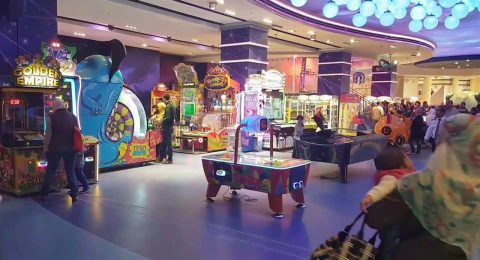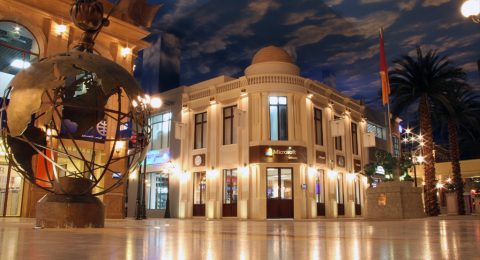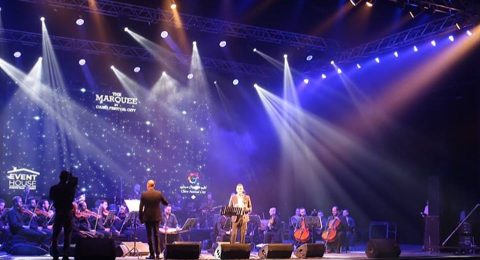Lately, retailers are investing more in “customer experience” to boost in-store traffic and sales. As a reaction to the evolving consumer shopping trends and changing demographics, developers and owners of shopping centers started to merge retail with new entertainment concepts; industry professionals often refer to this trend as “retailtainment” or “experiential retail.” This provocative combination started to grant retailers a refreshing magnetism, which keeps existing visitors loyal and draws in new shoppers into stores by offering fun activities and enticing experiences.
The pivotal tenants of these projects include entertainment, retail, arts and culture, movie theaters, restaurants, family entertainment centers (FECs), and indoor snow centers. But the key to success lies in building a unique tenant mix that combines all these components under one roof. A number of successful attractions are already incorporated in today’s shopping centers such as Ski Egypt, Little Explorers, and Magic Planet in Mall of Egypt, The Park in Mall of Arabia, and The Marquee and KidZania in Cairo Festival City (CFC).
Invest-Gate delves more into this trend by exploring the reasons behind it, its impact on the retail sector and end-consumers, as well as, the obstacles hindering its application.
Why Retail Entertainment?

Generally speaking, modern shopping malls are common in Egypt, particularly in Cairo, and they are practically performing well, with a healthy footfall and retail spend. However, there are a couple of reasons that chiefly drove developers to race in creating more interactive retail developments to provide a different retail experience, and thereby, increase dwell time – the average time spent by consumers in a center.
Director of Healthcare, Education, and Public-Private Partnership (PPP) Sectors at Colliers International Mansoor Ahmed notes that the influx of supply also prompted competition to fiercely stem amongst shopping center developers to stand out in the market and futureproof their shopping malls.
Piggybacking Ahmed’s sentiment, the total supply of retail space in Cairo reached around 2.1 mn square meters in 2018, while expected to increase by another 375,000 square meters of retail space, based on JLL’s “A Year in Review 2018” report on the city’s real estate market.

The rise of e-commerce is another reason. Egypt scored the highest growth of online shopping in the Arab World, with a 32% increase in the volume of payments, according to Payfort’s 2017 report “State of Payments in the Arab World.” People aged 26-35 years were the largest age group to buy products online – a fact that paves the way for the potentiality of online purchases to continue growing in Egypt, since the majority of the population under 30 years old, the study indicated.
However, Ahmed highlights that
“The relatively young demographic is known to enjoy entertainment, dining out, and spending time experiencing new concepts in the market. Therefore, the retail offerings in Greater Cairo eventually evolved to cater to the needs of this age group.”
“Developers have defined products and facilities that meet the requirements of such demographics, such as FECs, edutainment centers, cinemas, arcade game halls, escape game areas, and indoor sports activities,”

In fact, real-life experiences provide consumers with a long-lasting sense of happiness and fulfillment than buying new things, according to a study conducted by Thomas Gilovich, a professor at Cornell University. Gilovich further highlighted that people are now moving away from traditional retail, buying new things, or even going to malls, for seeing themselves doing a chore rather than a fun activity. That is why adding entertainment and similar concepts to the retail mix is now becoming one way for retailers and shopping centers to lure consumer foot traffic, while making them less enamored about buying goods.
Benefits Across the Board

Mingling leisure, and food and beverage (F&B) within shopping centers is a relatively new and evolving trend, yet it notably impacts the retail industry. Colliers’ Ahmed sees a positive relationship between the entertainment offering in any retail development and its performance. The mall’s occupancy and rental rates, alongside retail density, get positively impacted by the surge in footfall and dwell time that usually come with adopting the retailtainment concept, resulting in high retail spending on all fronts, he explains.
To back up this assertion, a report dubbed “Ingredients for Success” by Urban Land Institute (ULI) and JLL in November 2016, acknowledges that the integration of leisure and F&B outlets raises retail sales and footfall by 6.2% and 5%, respectively, while reducing vacancy rates by 95 basis points – or 0.95%. This was identified based on the performance of eight shopping centers in Europe, who recently upgraded or extended their properties to include additional leisure and F&B spaces.

Basil Ramzy, CEO of Marakez, adds that
Incorporating such concept in any mall contributes to its overall positioning among other market players. This can be attributed to the fact that “embracing a consumer-driven experience through innovative engagement spaces centered around entertainment attractions helps the developer’s project become a destination for the surrounding community.”
For his part, Ahmed elaborates that
The remarkable tenant mix not only attracts high-end retailers but traditional ones as well; it also gives leverage to developers/landlords to raise rents on tenants. In general, leaseholders are willing to pay premium rentals for such assortment and bow out of customary shopping centers, which originally come with limited/no entertainment retail spaces.
Nevertheless, the mall’s high footfall and dwell time are generally translated into higher trade volumes for tenants, who certainly do well out of the larger pool of consumers. For example, F&B tenants are directly benefiting from the higher inflow of customers targeting entertainment offerings.

On the consumers part, Ramzy and Ahmed see that they are given access to avail the choice of experiencing various and distinctive entertainment elements under one roof within the convenience of a shopping mall. As an example, Ahmed says, “Consumers can combine weekly convenience retail chores, alongside these leisure activities. Young families can also leave their children to enjoy FECs (such as KidZania) while shopping.”
Advantages of Retailtainment
Developers:
• Increases dwell time
• Supports bottom-line targets, such as increasing rental income and overall retail sales
• Ensures the success of retail units
• Attracts traditional and non-traditional tenants, and also retains them
• Improves the center’s vacancy rates
• Provides reasons for consumers to extend their visits, and thus, increases potential spending in the malls
Retailers:
• Lures a larger pool of consumers
• Increases trade volumes
Visitors:
• Offers an emotionally engaging experience
• Widens the range of reasons to go to malls and increases the frequency of consumers visits
• Allows visitors
What’s Next?

Despite the various opportunities that retailtainment offers on all fronts, it still brings forth a couple of challenges. Ahmed notes that some of the concepts being introduced by local developers are becoming repetitive in terms of entertainment offerings.
For this reason, JLL Country Head in Egypt Ayman Sami says:
There is an increasing pressure on retail developments to distinguish themselves more precisely, given the intense competition. “There is no room for traditional malls anymore since they do not get the right traffic.”

In Marakez CEO’s view:
Another challenge is immersing the customer in an experience that they respond to; this requires operational and financial investments. “Secondly, understanding how this impacts your bottom line, and predicting that will always be a hurdle to any investment committee.”
Therefore, shopping centers should keep in mind the following points when considering retail entertainment:
JLL’s Sami sees that any developer should identify the target audience and their preferences. Also, it is important to recognize other competitors, and acknowledge what they offer, he adds.
Ahmed recommends that developers should look for bringing in newer concepts not just from within the region, but also from the international landscape.
Attract and find the right mix of creditworthy retailers and entertainment tenants to ensure that the development appeals to the existing customers and brings in more visitors, according to Ahmed.
- Keep Pace With Emerging Trends
Ramzy notes, “At Marakez, we constantly undertake our own market research to identify new trends to be able to introduce unique services and offerings that meet our customers’ expectations and needs.”
- Choose the Right Location
Sami sees the development’s site is important for the genuine success of any retail developer. Developers should look for high demand areas.
Read more about the retailtainment trend in the real estate market on pages no. 28-31 of our May issue.